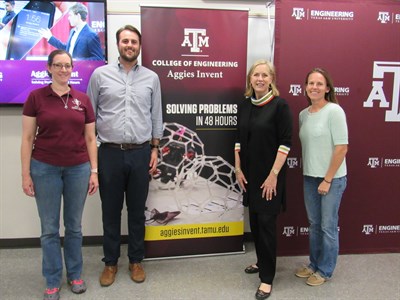Texas A&M’s College of Veterinary Medicine & Biomedical Sciences Participates in Aggies Invent
As veterinary care evolves and pet owners look for more personalized, convenient, and affordable resources to ensure their companions are happy and healthy, students focused on veterinary care are “stepping up.”

Six teams of students representing veterinary medicine, agriculture, and engineering met over a weekend in early April to participate in “Aggies Invent” – an intensive design experience that provides an environment to inspire and support entrepreneurship and innovate thoughts at Texas A&M; University’s Engineering Innovation Center (EIC).
“Aggies Invent is an enormously valuable program that changes the lives of participating students. They all broaden their view of the world and their role in contributing,” said Dr. Eleanor M. Green, the Carl B. King Dean of Veterinary Medicine. “Thanks to Rodney Boehm and the Dwight Look College of Engineering. I hope we can continue to hold Aggies Invent experiences with a veterinary focus.”
The Aggies Invent experience tasks participants with creating and developing solutions to problems many veterinarians face today.
Among the things the teams looked for during the activity were solutions to incorporate aspects of veterinary clinical skills training, the creation of sensors to monitor the health of non-verbal patients, and the implementation of new diagnostic tools. All agreed that there has never been a better time to transform veterinary care.
Each team had four to five students, the majority of whom were future veterinarians from Aggieland, including a graduate student in the master’s program, an undergraduate pre-veterinary student from animal science, and a veterinary student from the University of Missouri.
During the event, students in each group had 48 hours to create prototype solutions for issues they felt were pertinent to the veterinary community. Each presentation had a completely different theme, keeping the presenters, and the judges, on the edge of their seats as they waited for the next presentation.
“Aggies Invent provided a unique opportunity for our veterinary students to harness their formal education and experience toward solving real, tangible problems in animal health,” said Dr. Adam Little, director of Veterinary Innovation and Entrepreneurship. “Today’s graduates need to be able to work across disciplines, unpack problems, and utilize their training to create creative solutions for their patients, clients, and practices. It was incredibly rewarding to see the students go from an idea in their head to something tangible in such a short period of time. Many students were saying, ‘I can’t believe we were able to do that.’ We need to continue to unlock student potential at every opportunity.”
Banfield Pet Hospital, maxim integrated, and the Texas A&M University College of Veterinary Medicine & Biomedical Sciences (CVM) sponsored the weekend event.
First place went to the project Pawty Pals, created by team members Miranda George, Iran Ramirez, Sarah Jacobson, and Sam McDonald.
Pawty Pals was designed to address the underlying issue that owners might be unaware of the signs of emerging disease that their cats may be showing. These signs can be hard to see, and because of that, there has been a decrease in the number of veterinary visits from cat owners, despite the growth of cats as pets in the U.S. over the last five years.
With this developing problem, the team decided to evaluate how to more effectively recognize the clinical signs of disease that cat owners might be unaware of. The idea was to create a sensor that would collect data on a cat as it uses its litter box, including the frequency, duration, and, possibly, volume of these visits.
Second place went to Justin Campbell, Steven Michael Kouam Kenmognie, Emily Fauver, Kyle Novak, McCalley Cunningham, and Rachel Jorgensen for Pet Steps.
Pet Steps is a fun and interactive way to understand the important aspects of a pet’s health. The project encompassed a Pet Steps microchip, tag, and software app, providing a pet owner with everything they need for their pet to be happy and healthy. The product and technology provides innovative and effective ways to positively impact a pet’s health, giving the pet owner peace of mind and the veterinarian important data relating to the pet’s overall well being.
Third place was awarded to 3D Organizers, a project that involved implementing different 3-D printing techniques and materials to simulate critical surgical operations for veterinary students to practice before performing in the real world. The team comprised Joseph Kishpaugh, Elise Luo, Gabriela De Lima, Jessica Jiaie Xu, and Lee-Jae Jack Guo.
The top three winning teams were awarded $1,000, $750, and $500, respectively. The EIC, as well as Aggies Invent, offers support for students to continue working on their project, in addition to the prize.


